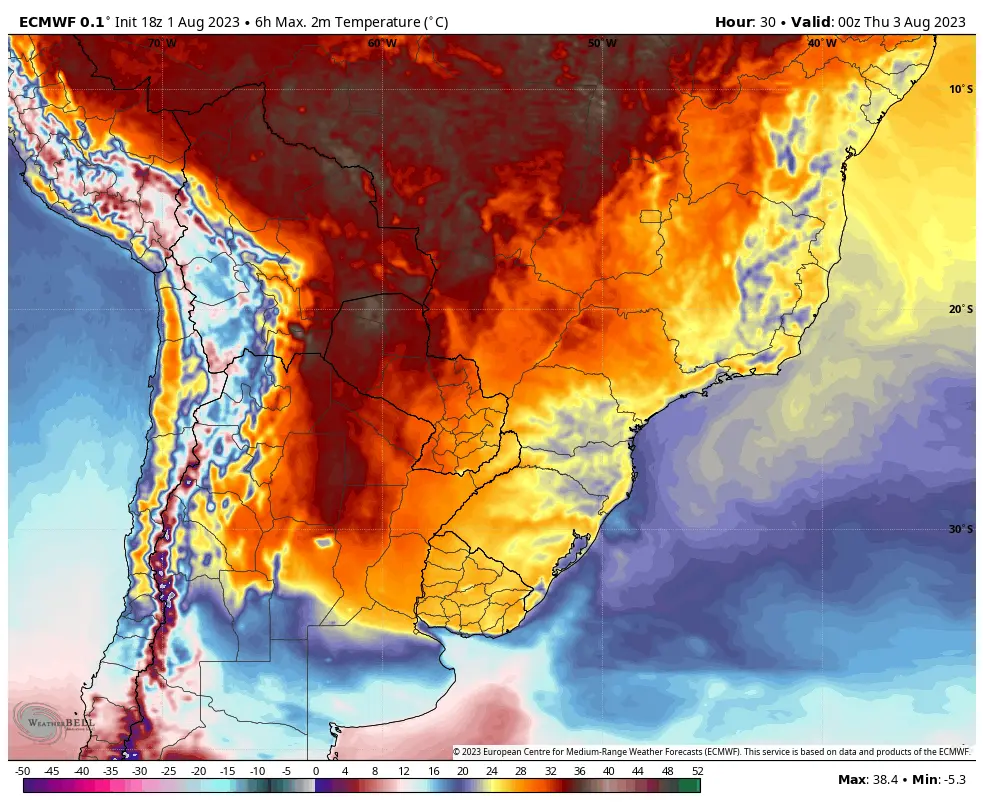It’s the middle of winter in South America, but that hasn’t kept the heat away in Chile, Argentina and surrounding locations. Multiple spells of oddly hot weather have roasted the region in recent weeks. The latest spell early this week has become the most intense, pushing the mercury above 100 degrees Fahrenheit, while setting an August record for Chile.
In Buenos Aires, where the average high on Aug. 1 is 58 degrees (14 Celsius), it surpassed 86 (30 Celsius) on Tuesday.
“South America is living one of the extreme events the world has ever seen,” weather historian Maximiliano Herrera tweeted, adding, “This event is rewriting all climatic books.”
The most extreme conditions have occurred in the southern half of the continent, and particularly in the Andes Mountains region.
Temperatures Tuesday rose past 95 degrees (35 Celsius) in numerous locations, including at elevations of about 3,500 to 4,500 feet in the Andes foothills. In some cases, the temperature crested above 100 degrees (38 Celsius) after leaping from morning lows in the 30s and 40s (single-digits Celsius).
Some places have even reached all-time maximums — surpassing summer temperatures, even though it is winter. This has occurred in locations with 20 to 30 years of climate data available, showing how exceptional this heat is compared with recent decades.
Like many other portions of the globe, record heat has visited parts of South America repeatedly in recent weeks. The big difference from its northern neighbors is that it’s winter there.
Parts of Brazil began to bake in mid-July, establishing record highs for the month as temperatures rose to at least 100 degrees (upper 30s Celsius). There was another spell of unusual heat during the third week of the month, which brought a slew of July records to Argentina, Bolivia, Paraguay and Uruguay.
A powerful zone of high pressure, or heat dome, centered over Paraguay is dominating the weather. It extends east to west across the south-central part of the continent.
August in the Southern Hemisphere is equivalent to February in the Northern Hemisphere. It shouldn’t be hot, let alone scorching.
Weather historian Thierry Goose tweeted that this was an “extraordinary winter heatwave” for Chile as the temperature climbed to 101.7 degrees (38.7 Celsius), a national record for August.
Vicuña and Chiguinto in the central part of Chile, about 230 and 320 miles north of Santiago, respectively, both reached that mark Tuesday.
Temperatures in the afternoon reached 4o to 45 degrees above normal (22 to 25 Celsius) for the date, and in some cases a bit more. Overnight lows have been exceptionally warm as well, ranging from above freezing in the mountains to as high as the 70s (mid-20s Celsius) in lower elevations.
This certainly raises concern if oscillating temperatures can cause heat spikes in winter. That’s gotta have all kinds of wild knock on effects.
Jesus just type F/C each time. Don’t find a new way to phrase their comparison for every mention of temperature.
how is it the middle of winter?
There are more places around the world than just your mobile park.
lmao
I’m just busting your balls. But seriously, stay in school kids.
Yeah fr, I had no idea about the axial tilt stuff. Wild
It’s definitely one of those things that seems obvious once you think about it but not something you would necessarily come to on your own.
Here’s another; an image of the moon from the southern hemisphere appears upside down compared to the moon you’re likely familiar with.
The Moon thing does make sense. But I genuinely thought Earth’s orbit had more eccentricity than that, and didn’t know the rotational axis was that skewed.
Certified science moment
Space is cool shit. Want to really get a new perspective?
So, obviously we’re on earth. The moon goes around the earth, and earth goes around the sun, right?
All the planets and the astroid belts, all moving around the sun. That’s our solar system.
Pretty cut and dry. But it goes further than that. Our solar system doesn’t stay in one place. The entire thing, us the planets moons the sun, everything is going around the center of the galaxy too. We’re blasting through space right now.
So you’re standing/sitting on a planet that’s spinning. While it’s spinning it’s traveling around the sun. While we’re traveling around the sun the sun itself is traveling around the galaxy dragging us with it.
And then of course the galaxy isn’t stationary either. Other galaxies and clusters of galaxies are pulling it along too.
Pretty cool shit
Yeah, and on top of that, our galaxy is probably yeeting through space at some ungodly velocities around the Local Group.
And on top of that, the Local Group is getting yeeted away from all the other galactic clusters in the (observable) universe at a speed that is, technically, faster than light.
That’s elementary school level education stuff, I’m worried for you.
Were you home schooled or are you 6 years old?
lol, relax
Southern hemisphere
While it is the southern hemisphere, almost all of the heat zone area shown here is within the tropics. The tropics do not have winter and summer as seasons.
The tropics and the rain forest are not thw same thing.
Chile, Argentina, and the southern portion of Brazil are not in the tropics of anything. Venezuela, Colombia, Ecuador, and the Guyanas are partly in the tropics.
Yes, they fucking are. For reference, here’s a picture of where the tropics end, note how the Tropic of Capricorn is south of the vast majority of the high heat area in the image.
You do realize that both Chile and Argentina aren’t in the image, right?
Notice how Argentina isn’t even on that map, and most of Chile isn’t either?
There are four seasons in most of the country: summer (December to February), autumn (March to May), winter (June to August), and spring (September to November).
One of the great minds of our time.
got my PHD at ligma university
Winter is June-August and August 4th falls somewhat in the middle of that timeframe.
Hang on, it actually gets colder there during June-August? That’s wild
Well shit. You blew me.
Winter in Brazil usually take place from June to September. Winter differs from summer with the high quantity of rains only.
Not usually. It happens every year! And also, that’s true only in the center and north. In the southeast and south it gets also way colder in winter. Not snow cold, but like 5°C or a bit less in some extreme occasions.
Winter usually differs from summer with the high quantity of rains only.
Oh hey, same for Israel.
And basically all tropical, arid, and temperate climates.
Tilt of the axis.








